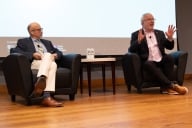You have /5 articles left.
Sign up for a free account or log in.
For such a mundane undertaking, reforming a campus’s back-office information system can be an expensive and risky prospect for a university CIO.
Larry Conrad knows this. Back when he was the chief information officer at Florida State University, Conrad remembers being called into the president’s office as he was about to preside over the implementation of a new information system -- known as an enterprise resource planning system, or ERP.
“He said, ‘If a project like this goes bad, you know what happens, right?’ ” Conrad remembers. “I said, ‘Yes: the CIO gets fired.’ And he says, ‘All right, as long as we’re on the same page.’ ”
With those stakes, one might expect that Conrad would take a conservative tack last year when his new employer, the University of North Carolina at Chapel Hill, decided to install a new ERP to manage its human resources, payroll and finances operations. But at a time when North Carolina, like many other states, is cutting funding to its public universities, Conrad decided to try to go a novel route -- one that he thinks could halve the estimated $10 million cost of switching over to the new system.
In order to do it, though, Conrad would have to join forces with the enemy: North Carolina State University.
OK, maybe that’s a little dramatic. But when it comes to recruitment, grants and basketball games, it can be rare to see Chapel Hill reach out to NC State with an unclenched fist.
Three things were different in this case: First, back-office information systems are not major differentiators between institutions; as Conrad puts it, “A faculty member, or a student, or a grant committee is not going to choose one university over another because of a great information system.” Second, tangible savings trumps an intangible rivalry when the budget is tight.
Third, Conrad’s counterpart at NC State happened to be one of his closest friends; Marc Hoit, the CIO at State, served in the top technology post at the University of Florida when Conrad was technology chief at Florida State. The two had collaborated on several projects, including one to connect Florida’s public universities and community colleges to the same high-speed internet backbone -- a project that cut the cost to each institution in half while improving Internet speed by a factor of 10.
Now Conrad and Hoit, by combining their ERP systems that govern human resources, payroll, and finances, think they can spare themselves the trouble of hiring 40 new staff between them. (Chapel Hill would have needed to hire 60 or 70 additional staff to run its new ERP alone, but sharing responsibilities with State would eliminate the need for 40 of those.)
That could save them a combined $3 million or more every year on staff, says Conrad, estimating roughly. Exactly how the two institutions will divvy staff savings has not been determined yet, he says, but the two CIOs say they plan to do so as equitably as possible.
The need for institutions to collaborate on technology is rising, says Conrad. A 2009 survey by the Campus Computing Project revealed that information technology budgets, like many others in higher education, were facing cuts. At the same time, demand for better IT tools is still rising, and those tools are often very expensive, says Conrad. Some colleges spend up to $200 million revamping their ERP systems, he says.
“You need to get a pretty good return to make that a good investment,” says Conrad. Overhauling information systems "sometimes costs more than the savings you get,” he says.
However, the savings are more likely to exceed the cost if systems are implemented at scale, says Hoit. Some state systems have consolidated technology investments, Conrad adds, but such collaborations are most often mandated from the top; voluntary partnerships between institutions that have not been instructed to form them are still relatively uncommon.
Large universities that have similar accounting practices and financial reporting guidelines -- state universities, for example -- can be particularly amenable to such alliances, the CIOs say. With institutions increasingly using electronic data systems and high-speed networks, splitting bureaucratic functions does not require common workspaces or filing cabinets; it takes two or more institutions that have similar data-management protocols and officials who are willing to work together.
Chancellors from both Chapel Hill and NC State last week told Inside Higher Ed they were not sure the universities could have agreed to do the collaboration if Conrad and Hoit had not been friends. The two CIOs say they don't know about that, but it certainly did make things easier.
After all, says Conrad, when the CIO’s job might be riding on a successful ERP renovation, it takes a lot of trust to put half of it in someone else's hands.
“Can you only do it if the CIOs are long-term friends? No,” he says. “But it does underscore that this is about trust.… There’s a certain level of betting your job on this. You can’t do this with someone you don’t trust.”
For the latest technology news from Inside Higher Ed, follow IHEtech on Twitter.








